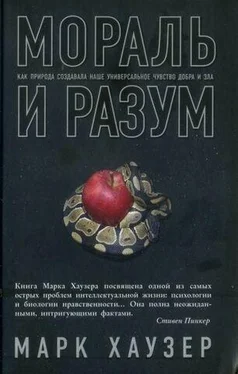Rozin P & Fallon A. E. (1987). A perspective on disgust // Psychological Review, 94, 23—41.
Rozin P, Haidt J. & McCauley C. R. (2000). Disgust // M. Lewis & J. M. HavilandJones (Eds.), Handbook of Emotions, 2nd Edition (p. 637—653). New York: Guilford Press.
Rozin P, Millman L. & Nemeroff C. (1986). Operation of the laws of sympathetic magic in disgust and other domains // Journal of Personality and Social Psychology, 50, 703—712.
Rozin P, Nemeroff C, Wane M. & Sherrod A. (1989). Operation of the sympathetic magical law of contagion in interpersonal attitudes among Americans // Bulletin of the Psychonomic Society, 27, 367—370.
Rubin D. (2002). Darwinian Politics: The evolutionary origins of freedom. Newark, NJ: Rutgers University Press.
Rubin P (2002). Darwinian Politics. New Brunswick, NJ: Rutgers University Press.
Ruffman T, Garnham W., Import A. & Connolly D. (2001). Does eye gaze indicate implicit knowledge of false belief? Charting transitions in knowledge //Journal of Experimental Child Psychology, 80, 201—224.
Ruffman T. y Olson D. R. y Ash T & Keenan T (1993). The ABCs of deception: do young children understand deception in the same way as adults? // Developmental Psychology, 29, 74—87.
Russell E. (1965). Scapegoating and social control //Journal of Psychology, 61, 203— 209.
Russell J. (1997). How executive disorders can bring about an inadequate ‘theory of mind* // J. Russell (Ed.), Autism as an Executive Disorder (p. 256—304). Oxford: Oxford University Press.
Russell J. y ]arrold C. & Potel D. (1994). What makes strategic deception difficult for children—the deception or the strategy? // British Journal of Developmental Psychology, 12, 301—314.
Sachs J. L. y Mueller U. G., Wilcox T P & Bull J. J. (2004). The evolution of cooperation // Quarterly Review of Biology, 79, 135—160.
Saffran J., Johnson E.,Aslin R. N. & Newport E. (1999). Statistical learning of tone sequences by human infants and adults // Cognition, 70, 27 —52.
Saffran J. R.,Aslin R. N. & Newport E. L. (1996). Statistical learning by 8-month-old infants // Science, 274, 1926—1928.
Sanfey A. G., Rilling J. K., Aronson J. A., Nystrom L. E. & Cohen J. D. (2003). The neural basis of economic decision making in the ultimatum game // Science, 300, 1755—1758.
Santos I., Flombaum J. & Hauser M. D. (in prep). Rhesus monkey expectations about object motion. Unpublished manuscript, Cambridge, MA.
Santos L. R. & Hauser M. D. (1999). How monkeys see the eyes: cotton-top tamarins’ reaction to changes in visual attention and action // Animal Cognition, 2, 131—139.
Sapolsky R. (1994). Individual differences and the stress response // Seminars in Neurosciences, 6, 261—269.
Sapolsky R. (1998). The Trouble with Testosterone. New York: Scribner.
Sapolsky R. (2001). A Primate’s Memoir. New York: Scribner.
Sapolsky R. & Share L. (2004). A pacific culture among mid baboons: Its emergence and transmission. Public Library of Science Biology, 2: el06. doi: 10.1371/journal.pbio.0020106 [2.
Saporta S. (1978). An interview with Noam Chomsky // Linguistic Analysis, 4 [4], 301—319.
Scheel D. & Packer C. (1991). Group hunting behaviour of lions: a search for cooperation // Animal Behaviour, 41 , 697—709.
Sckelling T (1960). The Strategy of Conflict. Cambridge, MA: Harvard University Press.
Schlottmann A., Alien D., Linderoth C. & Hesketh S. (2002). Perceptual causality in children // Child Development, 73, 1656—1677.
Schlottmann A. & Surian L. (1999). Do 9-month-olds perceive causation-at-a-distance? // Perception, 28 , 1105—1113.
Scholl B. J. & Nakayama K. (2002). Causal capture: contextual effects on the perception of collision events // Psychological Science, 13 , 493—498.
Scholl B. J. & Tremoulet P. (2000). Perceptual causality and animacy // Trends in Cognitive Science, 4, 299—309.
Schultz W., Dayan P & Montague P R. (1997). A neural substrate of prediction and reward // Science, 275, 1593—1599.
Schultz W. & Dickinson A. (2000). Neuronal coding of prediction errors // Annual Review of Neuroscience, 23, 473—500.
Sethi A. у Mischel W.y Aher J. L., Shoda Y & Rodriguez M. L. (2000). The role of strategic attention deployment in development of self-regulation: predicting preschoolers’ delay of gratification from mother-toddler interactions // Developmental Psychology, 36, 767—777.
Seyfarth R. M. & Cheney D. (2003). Hierarchical social knowledge of monkeys // F. В. M. d. Waal & P L. Tyack (Eds.), Animal Social Complexity: Intelligence, Culture, and Individualized Societies (p. 207—229). Cambridge, MA: Harvard University Press.
Seyfarth R. M. & Cheney , D. L. (1984). Grooming alliances and reciprocal altruism in vervet monkeys // Nature, 308 , 541—543.
Shakespeare W. (1914). Macbeth. London: Oxford University Press.
Shallice T (1988). From Neuropsychology to Mental Structure. Cambridge: Cambridge University Press.
Shaw G. B. (1916). Pygmalion. Bartleby. Available: http://www.bartleby.com/138/.
Shepher J. (1971). Mate selection among second generation kibbutz adolescents and adults: incest avoidance and negative imprinting // Archives of Sexual Behaviour, 1, 293—307.
Sherman N. (1989). The Fabric of Character: Aristotle’s Theory of Virtue. New York: Oxford University Press.
Shimizu Y. A. dc Johnson S. C. (2004). Infants’ attribution of a goal to a morphologically unfamiliar agent // Developmental Science, 7, 425—430.
Siegal M. & Peterson С. C. (1998). Preschoolers’ understanding of lies and innocent and negligent mistakes // Developmental Psychology, 34, 332—341.
Sih A. & Mateo J. (2001). Punishment and persistence pay: a new model of territory establishment and space use // Trends in Ecology and Evolution, 16, 477—479.
Silk J. (2002a). The form and function of reconciliation in primates // Annual Review of Anthropology, 31, 21—44.
Silk J. (2002b). Practice random acts of aggression and senseless acts of intimidation: the logic of status contests in social groups // Evolutionary Anthropology, 11, 221—225.
Silk J. B. (2003). Cooperation without counting: the puzzle of friendship // P Hammerstein (Ed.), Genetic and Cultural Evolution of Cooperation (p. 37—54). Cambridge, MA: MIT Press.
Simon H. A. (1990). Invariants of human behavior // Annual Review of Psychology, 41, 1—19.
Singer P (1972). Famine, affluence, and morality // Philosophy and Public Affairs, 1/3, 229—243.
Singer P (1993). Practical Ethics. Cambridge: Cambridge University Press.
Singer P (2000). A Darwinian Left. New Haven, CT: Yale University Press.
Smetana J. (1995). Morality in context: abstractions, ambiguities and applications // Annals of Child Development, 10, 83—130.
Smetana J. (2005). Social-cognitive domain theory: consistencies and variations in children’s moral and social judgments // M. Killen & J. G. Smetana (Eds.), Handbook of Moral Development. Mahwah, NJ: Lawrence Erlbaum Publishers.
Читать дальше











